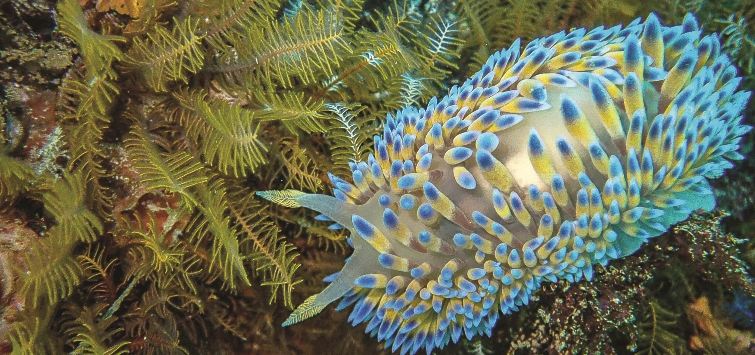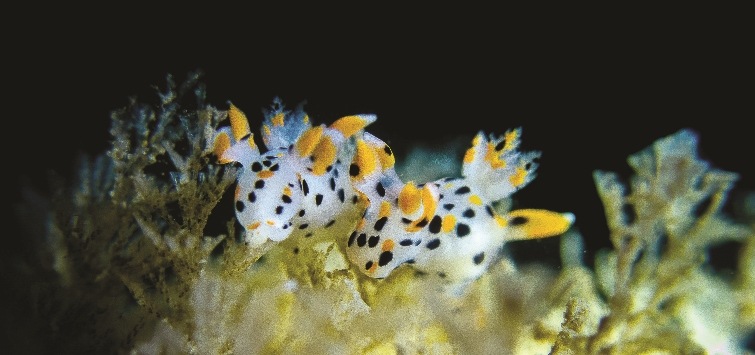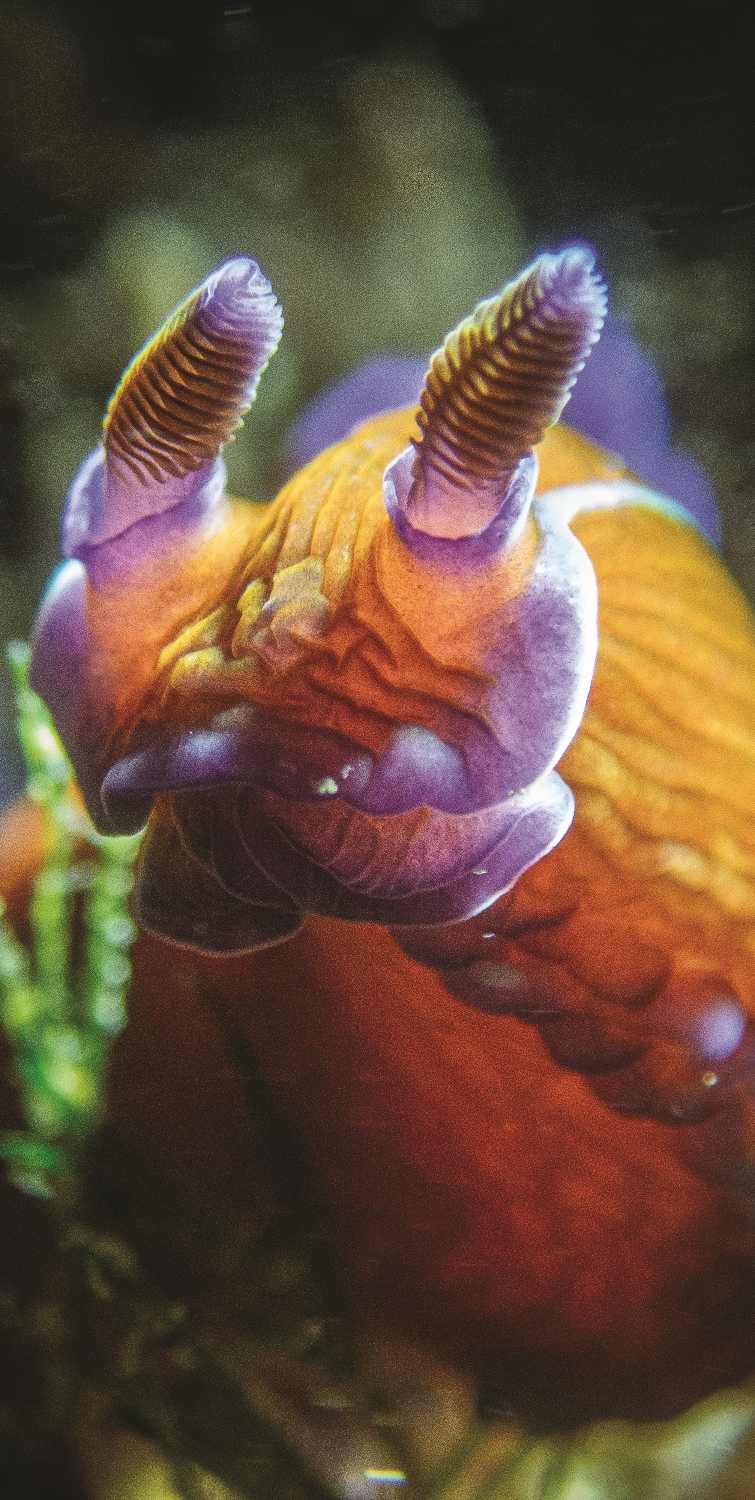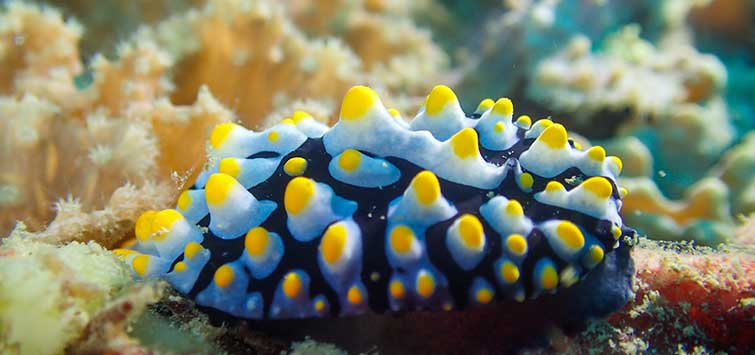Exploring the World of Nudibranchs & Other Sea Slugs
Author: Helen Walne
Slugs. Just the word conjures up taupe-colored, squishy creatures that slime out of their humid pits at night to devour gardens and leave silvery trails across patios. I once jogged with one lodged in my running shoe; needless to say, I threw those socks away.
But sea slugs! Now, they’re a different story. Where land slugs are usually as dull as a tax return, sea slugs—particularly the ones known as nudibranchs—are a carnival of color and texture, some with added glitter and glam, others with big floofy butts that are actually their gills. Yup, that’s right: Some of them breathe through their butts.
What Is a Sea Slug, Anyway?
The name “sea slug” is applied to a lot of different animals, most of which are nudibranchs, though some aren’t. They’re all gastropods without shells, just like your garden slug is basically a snail without a shell. But some species actually do have shells; they’re either very small and hidden, or sometimes internal.
The word “nudibranch” is often even put on some of non-nudibranchs’ names. For example, the bright green “lettuce nudibranchs” of the genus Elysia are actually sacoglossans, but that’s a bit of a mouthful when you could just call them lettuce nudibranchs. The best-known sea slugs in the aquarium hobby are sea hares, members of the family Anaspidea, and they are also not nudibranchs. a
But, for simplicity’s sake I’ll just use “nudibranch” and “sea slug” informally, as the misnomer is part of the name of a lot of these cool animals. (And to add to the confusion, there are animals that aren’t even gastropods and get called “sea slugs,” like some sea cucumbers, but they’re not going to be discussed here.)
My Early Sea Slug Encounters

When I first started snorkeling in tide pools around Cape Town, I dreamed of spotting a gas flame nudibranch (Bonisa nakaza). Seemingly, they were everywhere: Friends posted pictures of them on Instagram, and fancy local divers with camera rigs as big as borehole drillers shared shots of them caught in the spotlight, like runway models.
Then one morning, flapping around in a tide pool in front of a pub, with nobody watching but two bored gulls, I squealed through my snorkel. Finally! It didn’t look exactly the same as the ones in the pictures, but I was sure I’d broken the spell and found my first “nudi,” as they are often called for short.
I snapped a bad, blurry picture with my old camera and sent it off to my nudibranch-guru friend as soon as I got out of the water. She replied a few minutes later: “Nice anemone.”
Since that day a few years ago, I have become less flappy in the water and been lucky enough to spot most of the nudibranch types that occur in Cape Town’s chilly waters. When I eventually spotted my first gas flame (for real this time), I couldn’t believe I had missed them for so long. They’re huge, some the size of hamsters, and perfectly named: They look like a ring of flame on a gas stove, licking in yellow and blue. It’s audacious.
Nudibranchs are shell-less marine mollusks, and their name is derived from the Latin nudus (“naked”) and Greek brankhia (“gills”), due to the fact that most of these animals have external, exposed gills—those floofy butts referred to earlier or, in some cases, in branches sprouting out of the mantle. Many nudis, particularly aleoids, also have what appear to be spiky hairdos on their backs, structures called cerata, which help them absorb oxygen and sometimes help them defend themselves.
Most nudibranchs also have horn-like structures on their heads, called rhinophores, which help the animal feel their way around. Additionally, if you peer closely or have a camera with a macro function, you can make out tiny, black eye spots that help them detect light, shade, and movement.
Sea slugs are found in oceans across the world, with their appearance and behavior varying according to water temperature and what food is available. Some of the sea slugs found in the sea around Cape Town are similar to ones found off North America. Our orange-clubbed nudibranchs (Limacia clavigera), with their orange-tipped protrusions resembling matchsticks dipped in pollen, are akin to the cockerel’s nudibranch (Limacia cockerelli) found off the west coast of North America. The tiny plant-sucking nudibranch Elysia sp., found in tide pools and shallow bays grazing on Codium (a type of green seaweed), is similar to the hedgpeth’s sapsucker (Elysia hedgpethi) commonly found in the San Francisco bay. And our cowled nudibranchs (Melibe rosea) are as alien-looking as the hooded nudibranchs (Melibe leonina) found in the eastern Pacific Ocean.
But it is the elusive endemic slugs that send divers in Cape Town into an anxious frenzy. As a freediver, I have single breaths with which to seek out these tiny treasures (the scuba divers gliding by often make me jealous). But part of the excitement of nudi hunting is finding one, and then returning again and again to photograph it, mapping it out in your mind so you know exactly where it is.
Often our community of freedivers will share poorly drawn maps of where the latest rare find has been spotted. These are often accompanied by descriptions only nudi nerds will appreciate: a little to the right of the lumpy sea star, just below the patch of orange sponge, right where Josh lost his mask, by where the pajama sharks usually sleep.
Some of My Favorite Sea Slugs

Giraffe-spot nudibranchs (Ancula sp.) are among my favorite endemic species. Tiny, with plump white bodies and regular brown patches, they resemble tiny little giraffes (sans the long neck) and are commonly spotted in shallow water. I’ve only spied these bryozoan-munching critters twice, about five years ago, and despite much scrambling through the kelp, clinging on to rock walls and making my eyes go squint, I haven’t been able to find them since.
This is the mystery of nudibranchs. Their breeding and migration patterns are often not well understood. For example, every winter scores of four-color nudibranchs (Godiva quadricolor) arrive in St James pool, a small man-made tide pool in False Bay, the “warmer” side of Cape Town’s Atlantic Ocean that is influenced by the subtropical Agulhas current.
These beautiful yet ferocious predators, which feed on anemones and other nudibranchs, forage along the walls of the pool, decorating them with their zigzag-textured egg ribbons. Then, suddenly, they disappear, into what feels like the no-man’s land where socks and Tupperware lids go. Where do they go? And where do they reappear from? Even local nudibranch gurus are baffled.
Another favorite, which is similar to the giraffe nudi, is the feather nudibranch (Thecacera pennigera)—a small, piebald animal that resembles a sunny cow, with splashes of yellow and black, that can be spotted clinging to clumps of large branching bryozoans, waving around in the current, making it a tricky subject to photograph.
Much easier to snap is the black nudibranch (Tambja capensis), a velvety, smooth-bodied slug that is big enough to give macro photographers the opportunity to zoom in on their intricate, twirled rhinophores and even their soft-cornered mouths. Their name is at times misleading: while many of these slugs indeed appear black, with a turquoise line running down the middle of their bodies and a teal-colored floof of gills, some black nudibranchs are a coppery brown, while one variation I spotted was an audacious rainbow of colors that would have pleased the most flamboyant cabaret artist.
While it is not clear what causes these color variations, it is believed they could be due to what the slug is feeding on. We’ve all heard tales of humans turning orange from eating too many carrots, so it’s not too big of a stretch.
Finding Nudis: Follow the Foods

Food sources are key for sniffing out nudis. Once you learn what the different slugs eat, you can focus on the sponge/bryozoan/algae/kelp the various types prefer, and then zoom in even closer to discern the creatures, which are often heavily camouflaged. The commonly seen coral nudibranch (Phyllodesmium horridum)—its curly pink cerata resembling a 1980s permed hairdo—is often difficult to spot, curled into the body of soft coral. Crazed nudibranchs (Corambe sp.) are almost impossible to find, as they match the kelp bryozoan on which they feed, their pale, round bodies seemingly invisible against the crosshatch of the lace animal.
The red sponge nudibranch (Rostanga elandsia) feeds on—you guessed it!—red sponges, and its velvety texture blends in perfectly with the orange-colored sponges that grow so ubiquitously on the walls and reefs around Cape Town.
Sea slug diets are also a big part of what makes so many of them impossible keep in an aquarium. With a handful of exceptions, most are incredibly fussy eaters, often subsisting on a diet of one thing, and only that one thing. There are a couple of types that eat algae, such as the Elysia, but even then, it’s often limited to one type of algae, such as just Codium. More often, their diet is something like a particular type of sponge, or hydroid, or even a coral.
In most cases, this very limited food item isn’t available in the home aquarium. Even if it was, our tanks are seldom capable of producing enough of the food item to keep the slugs happy long term. Even the algae-eating species, like sea hares and lettuce nudibranchs, eventually wipe out most of their food sources and starve (and, ironically, unless the aquarist has taken steps to correct the cause of the problem algae, the algae usually simply rebounds, creating a never-ending cycle). In some cases, they may breed rapidly, overpopulating the tank, and increasing the rate at which they’ll exhaust the food supply.
Even if you magically had an endless supply of their very specific food item, aquariums are hostile places for delicate slugs. Relatively weak animals, they’re often pulled into pumps and destroyed by impellers. They can tumble down overflows. In many cases, they’re preyed upon by other animals in the tank—not only fish, but even microfauna, like ‘pods, or even other sluggos. Cannibalism isn’t uncommon in their world.
In this era of metaverses, SIMs, and Instagram filters, it’s a relief to know nature is weirder and more psychedelic than any virtual universe could hope to be. These tiny creatures are capable of performing magical tricks: plant-sucking nudibranchs convert the chloroplasts they get from algae into sugar to give them energy; cowled nudibranchs use their delicate hood to trap small crustaceans; sea swallows (Glaucus atlanticus) actively hunt down jellyfish and absorb the jellies’ stinging cells to use for their own defense; while iridescent nudibranchs are so sparkly they look as though they’re straight out of a Cher Christmas special.
These magical animals give us a window into a world as magical as the most fantastic cinema, a real-life planet Pandora from Avatar. Unfortunately, they’re not something we can or should even try to keep in the aquarium, and their magical world is best experienced with a mask and fins—or on these pages.
Flamboyant Dancers of the Sea
When the wind howls, the sea churns, and the visibility in the water is reduced to pea soup, nudibranchs are still there, snacking, arguing, mating, laying eggs, and fighting off the advances of hungry fish. All you need is a flashlight, a macro lens, sharp eyes, and a desire to be entranced by a miniature universe most people don’t even know exists.
But once you spot that first flamboyant, Vegas-costumed dancer bobbing in the brine, you’ll be hooked. Maybe you’ll even start drawing terrible maps to terrific sights and squealing into your snorkel when you come across a tiny spot of glittery slug-ness slinking over a swathe of sponge.

.png?h=595&iar=0&w=2781&hash=5FD5E69473BCC22199FBFA2FB71B6033)



